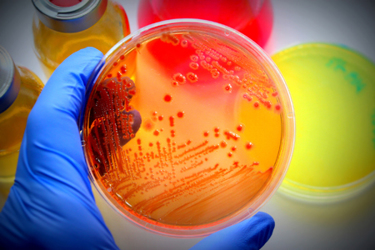Considerations For Microbial Enumeration Methods When Working With CDMOs
By Miriam Guest, principal microbiologist, AstraZeneca

Confirmation of microbial quality of drug products manufactured by contract manufacturing organizations (CMOs) is a key component of product release.
Microbial quality is not assured by end product testing alone; however, it is a critical release attribute. Compendial methods for microbial enumeration can be found in the harmonized pharmacopeias (USP, Ph. Eur., JP1,2,3). Within the framework of the compendial chapters, there are a variety of approaches that can be made to meet the requirements. In my last article, I provided an overview of considerations for sterility test methods when working with CDMOs. In this article, I provide a summary of microbial enumeration methods when working with CDMOs.
In microbial enumeration testing, the product-specific interferences are addressed during method development. The test article can interfere with the test, for example, by causing inhibition of the proliferation of microorganisms or, in some cases, challenging the detection of microorganisms.
The execution of method qualification, suitability, and validation can vary between laboratories. The reagents used, equipment, and level of experience can all impact the outcome of a microbiological method. It is essential the product-specific method is demonstrated to be suitable in the laboratory that is conducting the routine testing.
The guidance provided in USP<1117> Best Microbiological Practice4 highlights the importance of supplier oversight in microbiological services. For example, if a third party is used for microbiological testing, the supplier must have appropriate knowledge to ensure adequate oversight.
General Considerations For Microbial Test Methods
Building off the assurance of suitability of nutrient media to be used in testing is described in my last article. For the microbial enumeration test, additional consideration is given to the quantification of the recovered organisms and comparing the performance with previous batches.
If the company is claiming to have met the requirements of USP<61>,5 Ph. Eur. 2.6.126, or JP 4.057 then both nutrient medias (soybean casein digest and sabouraud dextrose agar) must be used at the two prescribed temperatures (30 to 35°C and 20 to 25°C).
General Considerations For Microbial Enumeration Tests
In method suitability testing, inhibition of microbial proliferation by the test article can be detected. In those circumstances, a strategy to overcome inhibition can be adopted; this may include the use of neutralizing agents in either the diluent used to prepare the product sample and/or the use of increased dilution factors. These topics should be discussed between the testing laboratory and the company’s microbiology SME to ensure the approach is scientifically sound, robust, and agreed upon.
In cases where the test article is diluted ahead of testing, variation in dilution factors used as a primary starting point may also vary between laboratories; understanding this ahead of new materials method development activities is helpful to understand the pathway to a suitable method.
Considerations For Membrane Filtration For Microbial Enumeration
Membrane filters used in microbial enumeration test are incubated on a nutrient solid agar. The filters are positioned to ensure the contact between the filter membrane and the media is uniform. However, there are a range of approaches to this.
The drug product is filtered through the membrane; these funnels can be multi-use and cleaned and sterilized at the site of use prior to use, or they can be single-use, which are purchased ready to use. The multi-use funnels have benefits in terms of reducing the waste burden of single-use plastics; however, they require additional manipulation for the transfer of the membrane to the nutrient media. For example, a clamp may need to be opened and the funnel separated before sterile forceps are used to transfer the membrane. For ready-to-use funnels, which are supplied sterile, some are individually wrapped, and others are delivered in trains of a number of units. In the case of ready-to-use funnels, the membrane can be transferred to a prepared agar “cassette,” where the membrane is simply clicked into place and the funnel discarded before the cassette is lidded or, in some cases, like the multi-use systems, the membrane is transferred using sterile forceps to the nutrient media.
A further difference is in the material of construction for the filter membrane. Examples include PVDF (Polyvinylidene difluoride) or cellulose acetate. The filters can also differ in color, which is a consideration for the detectability of microorganisms. Some laboratories will prefer to use a gray filter membrane and some, white.
Product compatibility can also influence filter selection. In some cases, a product may be incompatible with a membrane type, leading to product-specific selection of membrane filters, while in other cases, excess product may be retained on the membrane, which could cause inhibition or challenges in enumeration. In those circumstances, changing the filter type or adding additional rinse fluids may mitigate these issues.
It is best practice to pre-wet the filter membrane with a suitable diluent prior to adding the test article. Test articles can be added to diluents prior to filtration to aid filtration speeds.
Typically, a rinse fluid is then used. Laboratories may have a standard approach to the use of rinse fluids; for example, they may use a 3 x 100 mL rinse, with sterile buffered sodium chloride peptone water, or perhaps a single rinse of 100 mL with Fluid D.
Considerations For Microbial Enumeration By The Pour Plate Method
Pour plate methods are typically adopted when the material cannot undergo membrane filtration, such as oral solid dosage forms. These methods mean the volume of test article exposed to the nutrient media may be less than that which is exposed to the membrane in the filtration test.
The test article is suspended in a suitable diluent, which may include a step of pre-warming the diluent to facilitate dispersion. Some laboratories crush tablets prior to adding them to the diluent (this may be necessary depending on the tablet’s coating material) and in some cases the test article may be readily suspended without additional manipulation.
The dilution factor should be minimized; however, it may need to be increased in circumstances where the product inhibits microbial proliferation. Where a product is inhibitory, alongside increasing the dilution factors, the use of neutralizing agents may be required. These may be added to the diluent and/or the molten agar which is used to prepare the pour plate itself.
Laboratories should have a qualified approach to tempering agar. During tempering and prior to use, the media should be well controlled. The media should be the appropriate temperature when added to the petri dish – if it is too hot, potential contamination could be destroyed; if it’s too cold, uniform pouring may not be achievable. The molten agar should not be used beyond 8 hours of tempering.
The petri dish size can also vary. A traditional 90-mm petri dish limits the volume of material that is plates; typically, 1 mL of the prepared product can be used on each dish. A large plate method can be developed, which facilitates use of 10 mL of the prepared product. The large plate method can have advantages, such as where the product renders the agar plate turbid by enabling further dispersion of the product matrix.
Summary
While there are harmonized compendial chapters for microbial enumeration, there are a number of ways to meet them.
Laboratory-specific practices may influence the outcome of the result, and the test article may also interfere with the performance of the test. It is essential that each laboratory conducting the microbiological test on the test article undergoes product-specific method suitability to confirm method performance.
When establishing contracts with the test laboratory, additional factors to consider are the processes for laboratory investigations and out of specification results and clear expectations of timelines for communication. In addition, sampling, storage of samples, and retention periods should be factored in. When working with CDMOs, it is important to build a relationship that facilitates open discussion and ensure that the sponsor has appropriate oversight of the testing that is being conducted on their behalf.
References
- United States Pharmacopeia (USP). The National Formulary, USP-NF 2022, Issue 1.
- European Pharmacopeia (Ph. Eur.), 11th Edition
- Japanese Pharmacopeia (JP), 18th Edition
- USP<1117> Microbiology Laboratory Best Practices, United States Pharmacopeia
- USP<61> Microbiological Examination of Non-Sterile Products: Microbial Enumeration Tests
- Ph. Eur. 2.6.12: Microbiological Examination of Non-Sterile Products: Microbial Enumeration Tests
- JP 4.05: Microbiological Examination of Non-Sterile Products
About The Author:
 Miriam Guest is a principal microbiologist in Pharmaceutical Technology & Development, Global Operations, AstraZeneca, working in the New Modalities and Parenteral Development group, based at the company’s Macclesfield site in the U.K. She has worked in pharmaceutical development for more than 20 years, in both microbiology and formulation laboratories and GMP manufacturing environments. More recently, she has been supporting complex supply chains and designing robust control strategies, including the associated regulatory authoring and interactions. She leads the AZ Global Microbiology Forum, bringing together the global network of microbiology labs to drive standardization and quality principals in microbiology. Guest devised and leads AstraZeneca’s 21st Century Microbiology Strategy to innovate, industrialize, and implement technology solutions to drive efficiencies and process robustness benefits. She is an active committee member of the Pharmaceutical Microbiology Interest Group (Pharmig) and is involved in various cross-industry consortiums, including BioPhorum and the M3 Collaboration.
Miriam Guest is a principal microbiologist in Pharmaceutical Technology & Development, Global Operations, AstraZeneca, working in the New Modalities and Parenteral Development group, based at the company’s Macclesfield site in the U.K. She has worked in pharmaceutical development for more than 20 years, in both microbiology and formulation laboratories and GMP manufacturing environments. More recently, she has been supporting complex supply chains and designing robust control strategies, including the associated regulatory authoring and interactions. She leads the AZ Global Microbiology Forum, bringing together the global network of microbiology labs to drive standardization and quality principals in microbiology. Guest devised and leads AstraZeneca’s 21st Century Microbiology Strategy to innovate, industrialize, and implement technology solutions to drive efficiencies and process robustness benefits. She is an active committee member of the Pharmaceutical Microbiology Interest Group (Pharmig) and is involved in various cross-industry consortiums, including BioPhorum and the M3 Collaboration.
